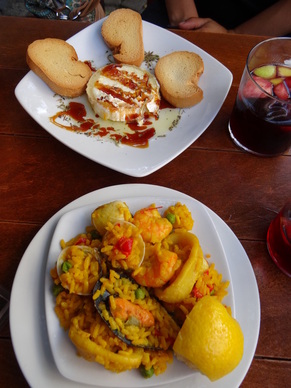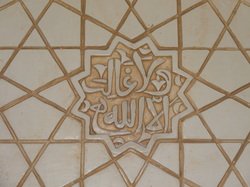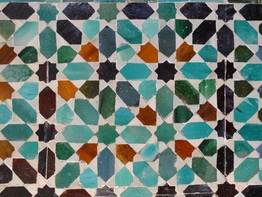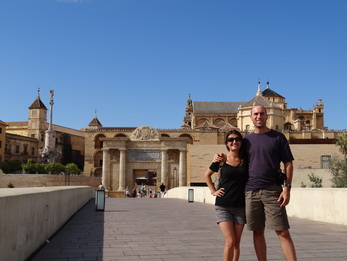



 Paella, Baked Goat Cheese, and Sangria Our arrival in Seville (and into Spain) was immediately greeted by some of the best offerings of Spanish culture. As it was late at night, we found a cervezeria right outside of our pension that was serving ice cold “tinto di verano” (wine of the summer) and delicious tapas. We stumbled through the language barrier to get a plate of delicious Iberian ham (similar to prosciutto in texture and taste) topped with aged cheese and some delicious albondigas (meatballs in a savory sauce). The next day we continued this onslaught of delicious bites with little plates of saffron speckled paella, baked goat cheese covered in fresh marmalade, and salmorejo, a chilled tomato and bread soup topped with boiled egg and the aforementioned Iberian ham. What a welcome to Spain! As we started to explore the city of Seville and learn about the region of Andalusia, we found that it wasn’t only our taste buds that would be excited. The rich history of the region leaves plenty of eye candy for even the casual observer. It all starts with Southern Spain’s rich Islamic history.  Arabesque Plasterwork In 711 A.D., Islamic leaders invaded the South of Spain (toppling the Visigoth empire that had temporarily ruled following the fall of Rome) and established the Kingdom of Al-Andalus, the root for the modern day territory of Andalusia. During their rule in Spain, the Islamic territories were a model of scientific research, artistic development, and religious tolerance (at least until 1100 or so). From the capital of Cordoba, the largest library in the world (at that time) was collected and massive investment went into the development of palaces and mosques, some of which still remain today. Islamic rule would continue strongly in the region until 1212, when North Catholic Kingdoms defeated most of the Muslim States established in Adalusia. The exception was the Nasrid Kingdom in Granada, which managed to last until 1492.  Azulejos - San Bartolome in Cordoba As we toured the palaces and mosques of Islamic Spain, we were awestruck by their use of simple substances like timber and plaster to create amazing décor in a style called arabesque. Imagine delicately carved plaster and carefully painted tiles (called azulejos) all coming together to form an endless interlacing of geometric forms. The Muslims believed that this stream of scrolling geometric patterns was an apt representation for eternity. Each piece is simple and beautiful in its own right, but when put into the context of hundreds of other pieces, the whole attains a beauty that the mind can barely begin to grasp. It’s a form of art that attempts to replicate how difficult it is for our finite minds to perceive something as vast and infinite as God. We started our tour of Moorish Spain with the Alcázar of Seville, a fortress turned palace largely built in 1364, after the fall of the region to the Catholic armies. However, it was largely crafted by Muslim craftsmen from Granada and retains a strong Islamic flair. Perhaps most memorable for us was the domed ceiling in the Ambassadors Hall consisting of carved and gilded interlaced wood (see picture above). From Seville we traveled to Granada, home of the most fascinating of the Islamic relics – the Alhambra. Consisting of an old fort, a palace, and some of the most stunning palatial gardens we have ever seen, the Alhambra is truly a sight to behold. It sits perched atop a hill overlooking Seville and our morning climb to get into the Nasraid Palace at the appointed time already had our hearts beating in anticipation (and exhaustion ;)). The Nasraid Palace is a wonderfully preserved example of the arabesque style and we had to hold our jaws in our hands as we gazed upon its beautiful courtyards, throne rooms, and the geometrically inspired ceilings. An early morning bus ride took us from Granada to the former Moorish capital of Cordoba where explored the Mezquita, a mosque originally built in 786 to establish Cordoba as the heart of Al-Andalusa. The Moors used bits and pieces of the Roman ruins around the city to create a “forest of arches” that creates much the same effect as the geometric patterns discussed above. It is like walking through eternity – at once both humbling but also inspiring. Unlike the impersonal experiences we often feel in cavernous and cold Christian cathedrals, the Moorish architecture brought an intimacy and aesthetic focus on the abstract that was very appealing for us. Perhaps by avoiding direct representation of the infinite (like a person or thing), it allows the mind to stay soft and open for whatever experience it may have of something so beyond comprehension. Unfortunately, the conquering Catholic royalty of northern Spain thought that it was necessary to tear down many of these mosques and build churches directly on top of them to express the domination of Christianity over Islam. In the case of the Mezquita, it was so large that the new rulers settled for putting an entire Cathedral in the middle of the Mosque. It is a very strange thing to see the Cathedral sitting there in the middle of the vast building. For the best illustration of it, see this video.  On the Roman Bridge leading to Cordoba For the Jews in Spain (known as Sephardic Jews), their fortunes changed with each conqueror. Jews were treated very poorly by the Visigoth’s who took over from the Romans, being forced to convert or leave the continent under their rule. When the first conquerors of Al-Andalus arrived, many Jews sided with them to get relief from the oppression. They were welcomed into Muslim society as dhimmis (non-Muslim members of monotheistic faiths). Their mastery of Arabic allowed for a golden age in which Jews held high positions in diplomacy, medicine, commerce, and agriculture. But as time went on, more conservative Muslim factions such as the Almohads took over Muslim Spain and Jews were forced to either convert or flee. Ironically, many did flee to the northern Catholic Kingdoms, who treated them well while they were needed to stabilize the government during the Reconquista (the battle by Christian royalty to retake Spain from the Muslims). But soon things would turn for the worse for Jews in Spain, as we’ll see when the blog post continues in Madrid and Toledo. For now we leave you with this link to all the wonderful pictures of Andalusia, as well as a mouthwatering picture of that delicious Salmorejo! We're headed to Portugal next!
0 Comments
Leave a Reply. |